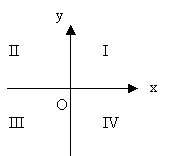
In the rectangular coordinate system shown above, which quadrant, if any, contains NO point (x,y) that satisfies the inequality 2x-3y<=(-6) ?
A. none
B. quadrant I
C. quadrant II
D. quadrant III
E. quadrant IV
An open Blog with tentative solutions and discussion of GMAT questions
Blogue para afixar e discutir a resolução de exercícios do GMAT
-----------
Contacts:
luisbotelhoribeiro@gmail.com ..... .............................
Paredes - Portugal
GMAT is a registered trademark of The Graduate Management Admission Council
, who does not endorse, nor is affiliated in any way with the owner or any content of this web site.
1 comment:
This type of linear conditions on x, y (normally GMAT would not go into upper order expressions...) lead to the division of the Cartesian x,y plane in two areas, divided by a straight line whose analytical expression can be found by substituting the inequality sign, in this case "<=", by an equality sign -> 2x-3y=(-6).
Doing this, we can start looking for the two intersection points of the line with x,y axes. Note that if there was only one intersection point, we would have the independent term (-6) equal to zero.
Letting y=0 we end up with x=-3, yielding the intersection point with the XX' axis ( -3, 0).
Letting x=0 we get y=2, yielding the intersection point with the YY' axis ( 0, 2).
Drawing these points on the diagram (even without any accurate scale) we find that the line crosses quadrants III, II and I. This menas that all these quadrants will necessarily have an infinite number of points in the region defined be the original inequality. The remaining question is wether quadrant IV is in or out. It is quite evident, from the diagram, that if the origin (0,0) satisfies the inequality, then will the quadrant IV. The opposite is also true. So let's test this point: (2x0-3x0 = 0) <= (-6) turns out to be False. So neither point O nor any point of quadrant IV satisfy the inequality, leading to the correct answer (E).
Post a Comment